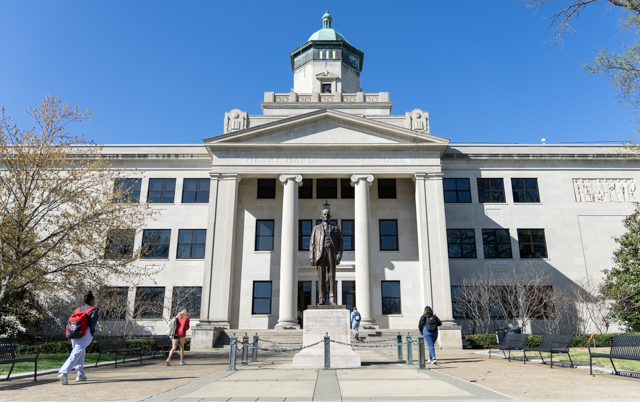EKU pulls ahead of WKU in degree-seeking enrollment
Published 6:00 am Wednesday, April 9, 2025


Western still leads in many enrollment measurements
DAVID MAMARIL HOROWITZ
david.horowitz@bgdailynews.com
Eastern Kentucky University announced recently that it’s become the largest regional public university in overall degree-seeking enrollment. Western Kentucky University had held that position since at least 2005, according to Kentucky Council on Postsecondary Education (CPE) data.
University of Louisville and University of Kentucky are recognized as Carnegie-classified research institutions rather than regional ones and are the largest public universities statewide; WKU has long ranked as the third-largest public university statewide, with EKU generally ranking fourth across numerous enrollment metrics, according to CPE data.
With 14,431 degree-seeking students in fall 2024, compared to WKU’s 14,154, EKU eked out an edge in “degree-seeking” enrollment by 277 students, attributing growth to “… focus on affordability, student support services and the Exceptional Eastern Experience.”
Concerning the reason for WKU’s taking second in “degree-seeking” enrollment, it’s most important to look beyond one enrollment metric, according to WKU Interim Vice President for Enrollment Management John-Mark Francis — and WKU remains the largest public regional Kentucky university across numerous enrollment metrics.
For example, when it comes to full-time degree-seeking enrollment, at 11,866 students, WKU remains the largest regional public university, according to CPE data. Its full-time enrollment of 12,070 also ranks first among public regional universities statewide. It’s the same, too, for total fall enrollment, at 16,293. When looking at students seeking bachelor’s degrees, it again ranks first at 11,577 students.
“When we assess and benchmark our enrollment, we take a pretty comprehensive approach, and we look at multiple metrics,” Francis said. “When you do that in measures including total enrollment, full-time headcount, baccalaureate degree-seeking status, full-time equivalent enrollment, WKU remains the largest comprehensive university in the commonwealth.”
WKU’s 4,272 degrees earned last academic year also surpassed EKU’s count by just over 20%.
Concerning the degree-seeking enrollment metric, Francis attributes WKU’s second-place position to its shift in focus from total headcount to other priorities: academic quality, student success, enrollment shifts due to increased retention and graduation rates, and a consideration of net tuition revenue. (WKU describes net tuition revenue as the financial resources available to the university after scholarships and aid.)
“We’ve got to make sure that we’re shaping the class in a way that allows us to remain accessible and open for students whose lives can be changed by a bachelor’s degree, but also positions us for financial stability and revenue stability through increased net tuition revenue,” Francis said.
Francis also confirmed that the decrease in international student enrollment, from more than 1,300 in 2015 to 163 in fall 2023, and the reorganization of the WKU-run community college in 2018 have affected enrollment as well.
A way many institutions achieve strictly growing headcount is by growing their rate of discounts, which include scholarships and aid, Francis said. Last fall, the average amount private universities nationally deducted from their sticker tuition cost increased to about 56%, according to Inside Higher Ed.
In comparison, Francis said WKU reduced the discount rate for freshmen by 11% and increased freshman net revenue by roughly 23%, more than $4.5 million, between fall 2023 and fall 2024.
“What we elected to do was to (…) take a more long-term approach that optimized predictable and sustainable revenue streams — and our fall enrollment did that: Total non-high school headcount is essentially flat, with less than 1% variance from the previous year, but most importantly, we were able to do it without driving up the discount rate and essentially buying more students,” he said.
Meanwhile, WKU has upped the academic standards for students: The university, under President Timothy Caboni, raised the minimum admissions GPA to 2.0 and required students with a GPA under a 2.5 to enroll in the Summer Scholars Program; other programs — for instance, those those surrounding scholarships and centralized advising — contribute toward developing a first-year class with a higher likelihood of graduating, Caboni has said.
“… it’s about ensuring that every student, regardless of where they begin, (has) the best chance of success with the least chance of getting themselves in debt with no degree,” Francis said.
Student success, he said, has also contributed to enrollment decline: The average time to a degree in the 2015-16 school year was 4.5 years — and the figure has steadily dropped to 4.03 years as of last year.
“That has reduced enrollment. If students are not sticking around for a fifth year or a sixth year, that means that they’re graduating, going into the workforce, and we’re not getting the tuition revenue,” he said. “Improving student success has an effect on overall enrollment, but it’s absolutely the right thing to do …”








